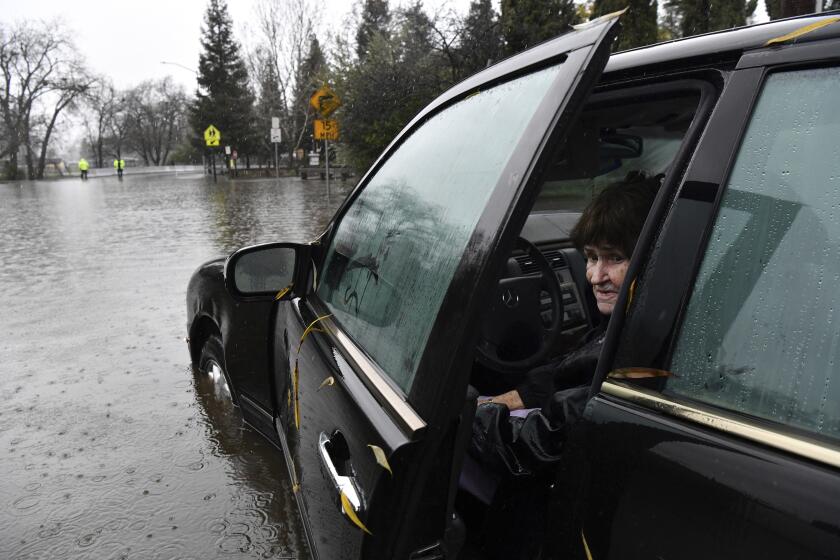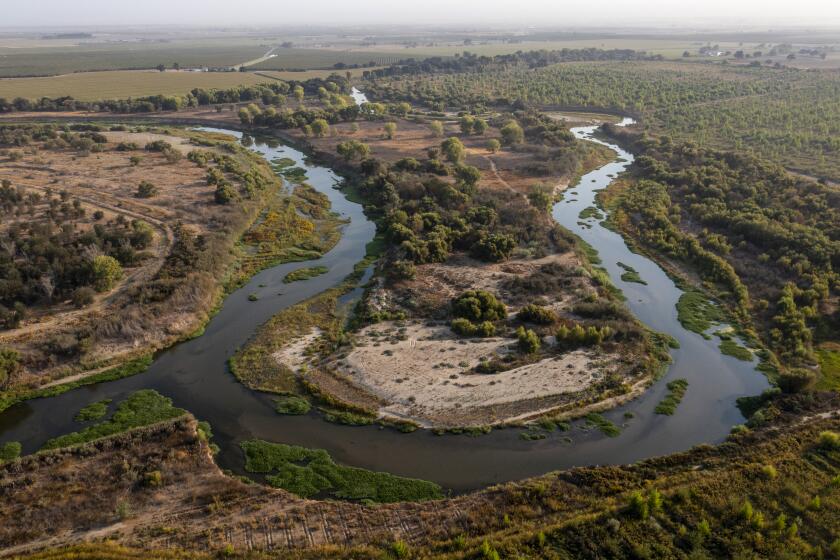Editorial: An unfair plan to cut California’s use of Colorado River water

- Share via
The immediate question before the seven states that use rapidly vanishing Colorado River water is not how to renegotiate the century-old agreement and accompanying laws that divvy up the supply.
California and other states will have to grapple with that problem soon enough, and it won’t be easy. Those accords were hammered out in an era when the Western U.S. was lightly populated, farmland was not yet fully developed and the climate — although few realized it at the time — was unusually wet. Now, when the thirst is greatest and still growing, the region is reverting to its former aridity, exacerbated by higher temperatures caused by global industrialization.
But the deadline for that reckoning is still nearly four years off.
The urgent question at present is what emergency steps the states must take in the interim to keep enough Colorado River water in two huge but dangerously depleted reservoirs to enable the dams to continue providing a lifeline of water and power to 40 million people in the southwestern U.S. The seven states have repeatedly blown their deadlines to agree to a plan, delays that most likely leave the decision to federal regulators.
It is clear that each state must agree to take far less than their agreements allow, simply because the full measure of water guaranteed does not exist. Nor has it, for decades.
Even as California gets yet another atmospheric river blast and snowpack nears twice the average for this date, we’re still in grave danger of running out of water.
But, in this in-between period, which state should cut the most?
The four states in the Upper Colorado River Basin — Wyoming, Utah, Colorado and New Mexico — have never used their full allocation and resist cutting the amount they currently take. Two states in the Lower Basin — Arizona and Nevada — likewise want to limit any losses, and it stands to reason. No state would voluntarily give up water without getting anything in return. It would be political suicide for each state’s elected leaders.
Together the six states upriver from California came up with a novel, if disingenuous, proposal: When calculating the amount of water used by each state, include the amount that evaporates in the Lower Basin before it reaches its destination.
The Colorado travels furthest to reach California, which uses the most water, so naturally — the argument goes — California should be on the hook for most of the evaporation. By the time the river flows into Lake Powell in Utah and Arizona, and then into Lake Mead in Arizona and Nevada, even before it actually reaches the section where it marks the Arizona-California border, much of California’s share is already in the atmosphere over those other states.
Very clever.
The six upriver states unveiled this argument in January. It was a public relations victory, because left unexamined, it sounds almost reasonable. California and the Metropolitan Water District had a different proposal, but the evaporation argument caught them flat-footed.
There are legal and creative ways to adjust water rights to meet the needs of a drier state. Federal water officials have triggered one of them.
But federal regulators should not be swayed. Evaporation was not part of the formula when all seven states entered into the Colorado River Compact in 1922, nor in the subsequent treaties, agreements and court decisions that together form what is known as the Law of the River. It’s a questionable measure even for the long-term recalculation that the states face in 2026. It has no legitimate place in discussions of short-term emergency measures.
All seven states need a more constructive approach that recognizes not merely the necessity of broad cuts all around, but of creative management of existing supplies. Nevada knew this when it wisely banned thirsty decorative lawns. The other states and their water agencies have likewise adopted smart strategies, none more so than the MWD, which is building a huge water recycling plant, and which voluntarily banked much of its supply in Lake Mead to keep the reservoir operating.
Half of all Americans who use Colorado River water to drink, cook, shower, flush or grow crops are Southern Californians. A huge portion of them are served by the MWD.
The Law of the River is complex and the peril of shrinking water supplies is serious. There are many painful decisions to make between now and 2026, debates about whether to restrict what farmers can grow and what developers can build, how to respect the water rights of Indigenous tribes and Mexico (where the river now dries up before it reaches the Gulf of California), whether and how to adjust the West’s first-come, first-served water laws.
First, though, the states need a fair and workable survival strategy, and soon. Nature has its own timeline, and it’s short.
More to Read
A cure for the common opinion
Get thought-provoking perspectives with our weekly newsletter.
You may occasionally receive promotional content from the Los Angeles Times.












